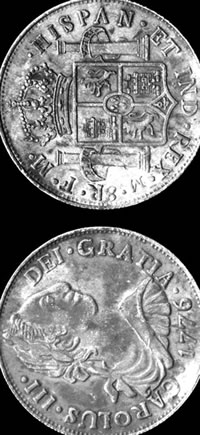
1776 Spanish coin found in old Nashville City Cemetery
"Very good possibility it could be the real thing"
Piece of eight was legal tender in the U.S. until the 1850sThe Tennessean reports here that a 1776 Spanish coin may have been found in the old Nashville City Cemetery:
Famously known as the "piece of eight" and later the "peso," a 1776 Spanish coin called the "8 reales" was found as workers were doing restoration recently on the old Nashville City Cemetery.The article goes on to quote a Madison coin shop owner on the "very good possibility it could be the real thing" even in light of the "huge business" of coin counterfeiting. According to the Tennessean, no appraisal has been conducted of this particular coin, and it is unknown where the coin's owner (or the coin itself) was at the time it was minted in 1776, if it is genuine. Nashville was founded in 1779 and incorporated in 1806.
The coin was found in the northeastern quadrant of the cemetery by Pat Cummins, staff archaeologist for the Murfreesboro-based Cumberland Research Group, which specializes in mortuary archaeology.
History of Spanish coins in British colonies, U.S.
According to Wikipedia, the "piece of eight" coin was frequently used in Britain's pre-Revolution American colonies, their manufacture having been outsourced here from Spain:Prior to the American Revolution there was, due to British mercantilist policies, a chronic shortage of British currency in its colonies. Trade was often conducted using Spanish dollars. Spanish coinage was legal tender in the United States until an Act of Congress discontinued the practice in 1857. The pricing of equities on U.S. stock exchanges in 1/8 dollar denominations persisted until the New York Stock Exchange converted to pricing in sixteenths of a dollar on June 24, 1997, to be followed shortly after by decimal pricing.
Long tied to the lore of piracy, "pieces of eight" were manufactured in the Americas and transported in bulk back to Spain (to pay for wars and various other things), making them a very tempting target for seagoing pirates.
What you see on the coin
The images on the typical pieces of eight/8 reales coin are of the profile of Charles III (obverse) and the Spanish coat of arms (reverse).The letters around Charles III read "CAROLUS III DEI GRATIA 1776" or "Charles III by the Grace of God, 1776" in English.
The letters around the Spanish coat of arms read "HISPAN[IARUM] ET IND[IARUM] REX M[EXICANUS] 8 R[EALES] F M" which in English means "King of the Spains and the Indies, Mexico [City Mint], 8 reales."
The Spanish coat of arms includes the Pillars of Hercules and the motto "Plus Ultra," which means "further beyond" in Latin. The message was that the Pillars of Hercules at the Straits of Gibraltar did not so much constitute an entrance to the Mediterranean but Spain's gate to the rest of the world. Source: Wikipedia (Spanish Dollar, Pillars of Hercules)
Image source: Wikipedia (public domain)

No comments:
Post a Comment